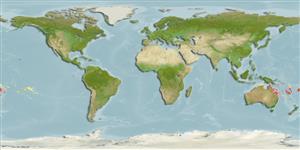Actinopterygii (ray-finned fishes) >
Perciformes (Perch-likes) >
Tripterygiidae (Triplefin blennies) > Tripterygiinae
Etymology: Enneapterygius: Greek, ennea = nine times + Greek, pterygion = little fin (Ref. 45335).
Environment / Climate / Range
Ecology
Marine; reef-associated; non-migratory; depth range 0 - 5 m (Ref. 13227). Subtropical, preferred ?; 11°S - 38°S
Western Pacific: northern Queensland to New South Wales, Australia. Recently reported from Tonga (Ref. 53797).
Size / Weight / Age
Maturity: Lm ? range ? - ? cm
Max length : 5.3 cm SL male/unsexed; (Ref. 54980)
Short description
Morphology | Morphometrics
Dorsal
spines
(total): 13 - 17;
Dorsal
soft rays
(total): 8-11;
Anal
spines: 1;
Anal
soft rays: 15 - 20. Presence of a black head mask in males, a black streak on the caudal peduncle in both sexes, blackish dorsal fins in males, a plain whitish anal fin, a pointed snout (snout angle 30-40°), 16-21 anal fin rays, 15-20 + 15-20 lateral line scales, and 2-3 median mandibular pores.
Adults are found on intertidal and subtidal areas, specifically on reef's surface, usually in weedy areas, on algal-covered rocks , or on rubble. They prefer silty habitat of upper regions, commonly on pylons, estuaries and harbors (Ref. 9002). They feed mainly on tiny invertebrates and algae (Ref. 2334). Eggs are hemispherical and covered with numerous sticky threads that anchor them in the algae on the nesting sites (Ref. 240). Larvae are planktonic which occur primarily in shallow, nearshore waters (Ref. 94114).
Life cycle and mating behavior
Maturity | Reproduction | Spawning | Eggs | Fecundity | Larvae
Fricke, R., 1994. Tripterygiid fishes of Australia, New Zealand and the southwest Pacific Ocean (Teleostei). Theses Zool. 24:1-585. (Ref. 13227)
IUCN Red List Status (Ref. 115185)
CITES (Ref. 94142)
Not Evaluated
Threat to humans
Harmless
Human uses
Fisheries: of no interest
More information
Age/SizeGrowthLength-weightLength-lengthLength-frequenciesMorphometricsMorphologyLarvaeLarval dynamicsRecruitmentAbundance
ReferencesAquacultureAquaculture profileStrainsGeneticsAllele frequenciesHeritabilityDiseasesProcessingMass conversion
Tools
Special reports
Download XML
Internet sources
Estimates of some properties based on models
Phylogenetic diversity index (Ref.
82805): PD
50 = 0.5000 [Uniqueness, from 0.5 = low to 2.0 = high].
Bayesian length-weight: a=0.00550 (0.00251 - 0.01205), b=3.08 (2.89 - 3.27), in cm Total Length, based on LWR estimates for this (Sub)family-body shape (Ref.
93245).
Trophic Level (Ref.
69278): 2.7 ±0.23 se; Based on food items.
Resilience (Ref.
69278): High, minimum population doubling time less than 15 months (Preliminary K or Fecundity.).
Vulnerability (Ref.
59153): Low vulnerability (11 of 100) .
